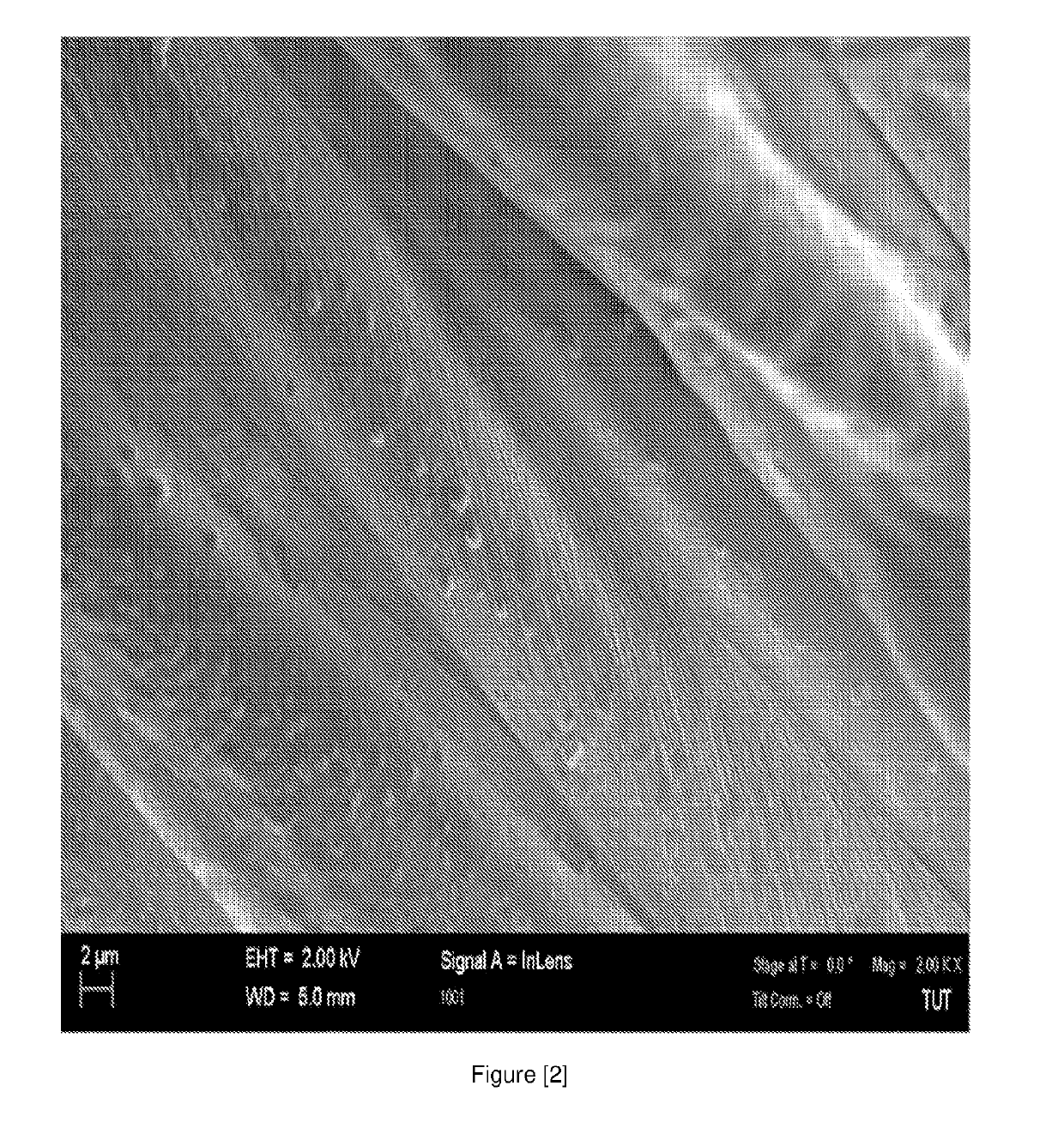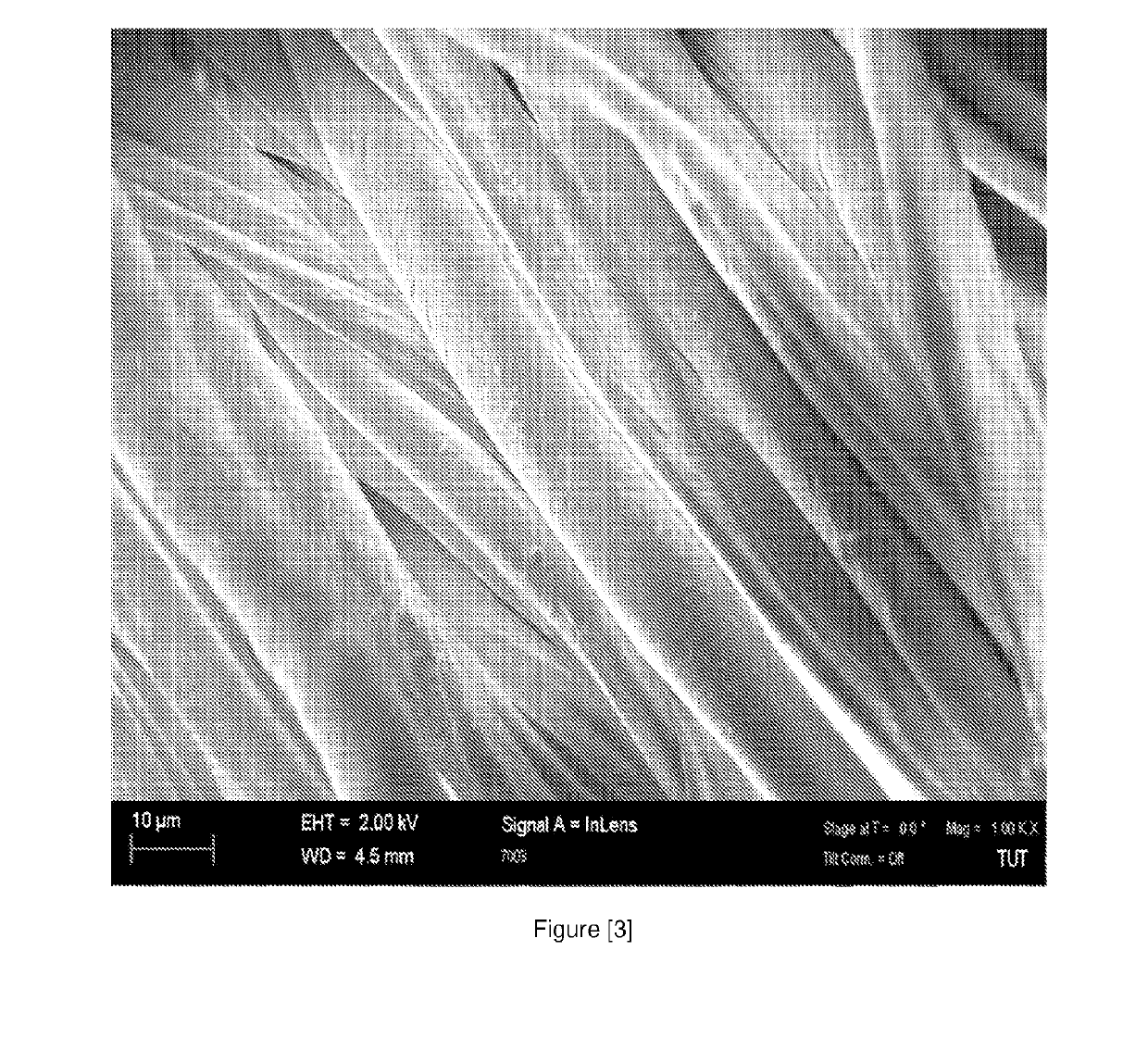Process for producing fibrous material with antimicrobial properties
- Summary
- Abstract
- Description
- Claims
- Application Information
AI Technical Summary
Benefits of technology
Problems solved by technology
Method used
Image
Examples
example 1
[0125]The rosin acid composition of coniferous resin acid composition obtained by distilling crude tall oil derived from Kraft pulping process of wood was analysed by gas chromatography according to standard method ASTM D5974. As shown in table 1 the rosin acid composition of the coniferous resin acid composition consists mainly of abietic acid, but there are also significant amounts of pimaric acid, palustric acid, dehydroabietic acid and neoabietic acid. For example, following ratios can be calculated from table 1 values: the ratio of pimaric acid to palustric acid is 1:1.1, palustric acid to abietic acid is 1:6.4, dehydroabietic acid to abietic acid is 1:8.4, neoabietic acid to abietic acid is 1:7, neoabietic acid to palustric acid is 1:1.1, pimaric acid to abietic acid is 1:7.
TABLE 1Rosin acid composition of the coniferous resin acid compositionRosin acid compositionWeight-%Secodehydroabietic18,15-Isopimaradien-18-oic acid0.2Secodehydroabietic acid 28,15-pimaric acid0.1Pimaric a...
example 1.1
[0129]In this example the water-soluble concentrate of coniferous resin acid composition was prepared with C14 / C16-alpha olefin sulphonate sodium salt 38% CAS 68439-57-6 as emulsifier and ethylene glycol monobutyl ether CAS 111-76-2 as solvent. Ethylene glycol monobutyl ether was chosen as suitable solvent because it has equal balance of hydrophobic and hydrophilic character, and it is one of the fastest evaporating glycol ethers. C14 / C16-alpha olefin sulphonate sodium salt was chosen as suitable emulsifier because it has low tackiness residual and outstanding wetting properties.
[0130]Preparation of the Water-Soluble Concentrate
[0131]The water-soluble concentrate of the active agent was manufactured by first determining the solubility of the antimicrobial agent in ethylene glycol monobutyl ether (CAS-111-76-2). It was found that 10% of antimicrobial agent can be dissolved in 90% of ethylene glycol monobutyl ether solvent for 30 minutes at room temperature and atmospheric pressure. F...
example 1.2
[0138]This example presents another embodiment, wherein the water-soluble concentrate of coniferous resin acid composition was prepared with ethoxylated oleamine as emulsifier and alkylamine oxide as wetting agent and ethanolamine as pH regulator. The thus manufactured aqueous solution of emulsified coniferous resin acid composition was then transferred into fibrous material by impregnation, and finally the fibrous material was after-treated to form a finished product, i.e. the fibrous material with antimicrobial properties.
[0139]Preparation of the Water-Soluble Concentrate
[0140]For the preparation of water-soluble concentrate, 20 g of coniferous resin acid composition was mixed with 110 g of isopropyl alcohol and complete dissolution was observed within 60 minutes. Then 5 g of pH regulator ethanol amine was added, and the mixture was stirred for 5 minutes. 15 g of ethoxylated oleamine emulsifier was added and the resulting mixture was stirred for 5 minutes. 100 g of wetting agent a...
PUM
| Property | Measurement | Unit |
|---|---|---|
| Temperature | aaaaa | aaaaa |
| Substance count | aaaaa | aaaaa |
| Volume | aaaaa | aaaaa |
Abstract
Description
Claims
Application Information
 Login to View More
Login to View More - R&D
- Intellectual Property
- Life Sciences
- Materials
- Tech Scout
- Unparalleled Data Quality
- Higher Quality Content
- 60% Fewer Hallucinations
Browse by: Latest US Patents, China's latest patents, Technical Efficacy Thesaurus, Application Domain, Technology Topic, Popular Technical Reports.
© 2025 PatSnap. All rights reserved.Legal|Privacy policy|Modern Slavery Act Transparency Statement|Sitemap|About US| Contact US: help@patsnap.com



